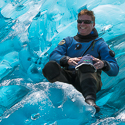[caption id="attachment_2549" align="alignright" width="250"]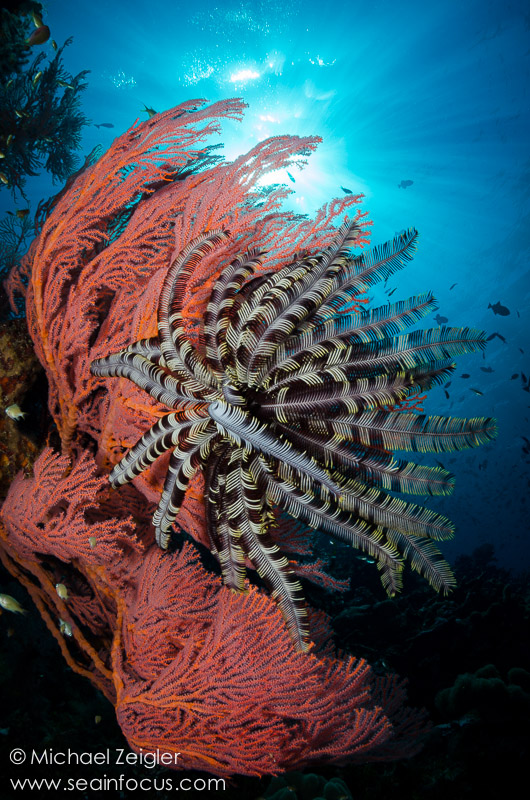 A large crinoid (feather star) clings to a large sea fan along the steep wall of Table Coral City - Wakatobi.[/caption]
The main ingredient when it comes to shooting sharp, colorful images underwater is to reduce as much of the water between the camera and the subject. This means getting as close as possible, sometimes only inches, from your subject. Fisheye lenses for underwater allow us the opportunity to capture large animals and reef scenes without the need to recompose from further away.
We can also force perspective, making for some dramatic shots. Fisheye lenses focus extremely close, making them suitable for use with both mini domes, like the 4” Zen DP-100, and full size domes like the 8’” DP-200 and 9” DP-230. For more information about dome size, please see “The Right Dome - Size Matters”.
We also want to shoot as close as possible to capture colorful images. Water filters out color, starting with the red channel, so images shot at depth will have a blue color cast. To bring back the color in our photos we use underwater strobes, but to use them effectively we need to be within about five feet or less from our subjects. The following are a few of our favorite Digital SLR fisheye lenses for underwater photography.
[caption id="attachment_2554" align="alignleft" width="250"]
A large crinoid (feather star) clings to a large sea fan along the steep wall of Table Coral City - Wakatobi.[/caption]
The main ingredient when it comes to shooting sharp, colorful images underwater is to reduce as much of the water between the camera and the subject. This means getting as close as possible, sometimes only inches, from your subject. Fisheye lenses for underwater allow us the opportunity to capture large animals and reef scenes without the need to recompose from further away.
We can also force perspective, making for some dramatic shots. Fisheye lenses focus extremely close, making them suitable for use with both mini domes, like the 4” Zen DP-100, and full size domes like the 8’” DP-200 and 9” DP-230. For more information about dome size, please see “The Right Dome - Size Matters”.
We also want to shoot as close as possible to capture colorful images. Water filters out color, starting with the red channel, so images shot at depth will have a blue color cast. To bring back the color in our photos we use underwater strobes, but to use them effectively we need to be within about five feet or less from our subjects. The following are a few of our favorite Digital SLR fisheye lenses for underwater photography.
[caption id="attachment_2554" align="alignleft" width="250"]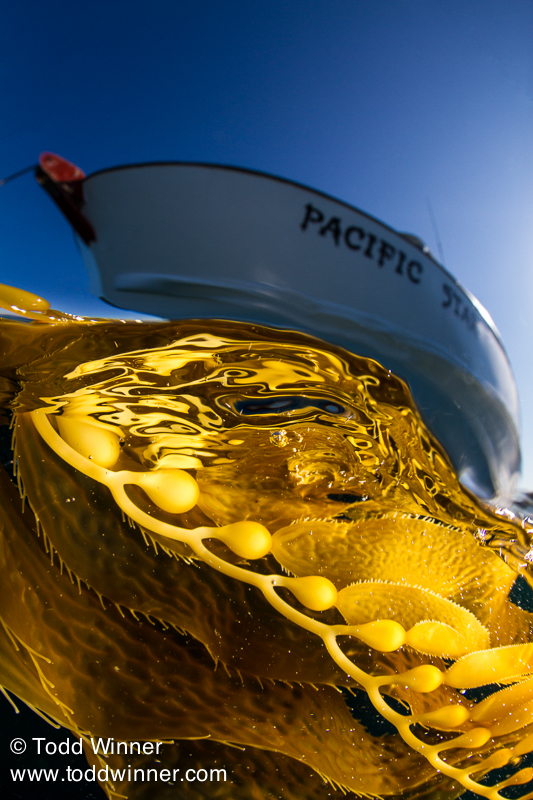 Split shot of giant kelp and a ship[/caption]
The Tokina 10-17mm f/3.5-4.5 is by far the most popular wide angle lens for crop sensor DSLRs. It is versatile with an equivalent range of about 15-26mm on a full frame sensor.
It’s available for both Canon and Nikon mounts and they do make the NH (no hood) versions without a built in lens shade for use with full frame bodies.
Just remember, that on a full frame body, you only have a usable zoom range of 15-17mm. Anything wider than 15mm and you will see rounded corners. It’s reasonably priced with excellent image quality.
The Canon 8-15mm f/4L is a dream come true for Canon underwater shooters. It can be used on both cropped and full frame cameras and has image quality equal or better than most fisheye primes. On a cropped sensor body like the EOS 7D, it is usable from 10-15mm.
Anything wider than 10mm will start to show rounded corners.
[caption id="attachment_2550" align="aligncenter" width="600"]
Split shot of giant kelp and a ship[/caption]
The Tokina 10-17mm f/3.5-4.5 is by far the most popular wide angle lens for crop sensor DSLRs. It is versatile with an equivalent range of about 15-26mm on a full frame sensor.
It’s available for both Canon and Nikon mounts and they do make the NH (no hood) versions without a built in lens shade for use with full frame bodies.
Just remember, that on a full frame body, you only have a usable zoom range of 15-17mm. Anything wider than 15mm and you will see rounded corners. It’s reasonably priced with excellent image quality.
The Canon 8-15mm f/4L is a dream come true for Canon underwater shooters. It can be used on both cropped and full frame cameras and has image quality equal or better than most fisheye primes. On a cropped sensor body like the EOS 7D, it is usable from 10-15mm.
Anything wider than 10mm will start to show rounded corners.
[caption id="attachment_2550" align="aligncenter" width="600"]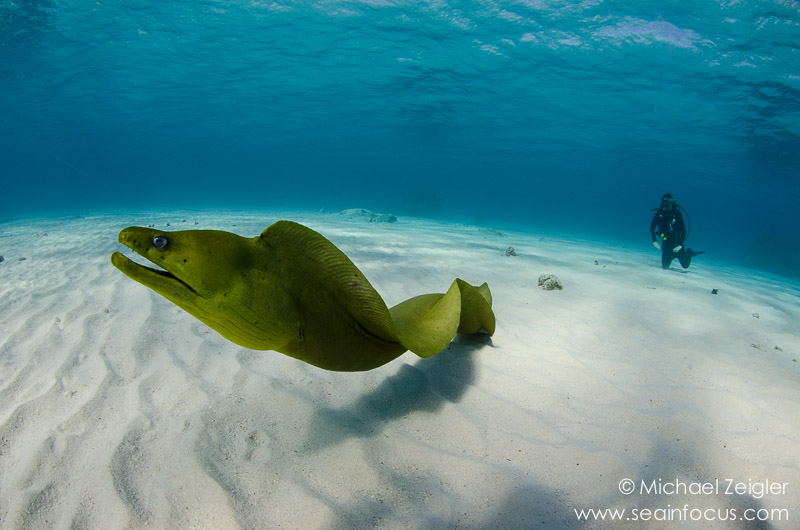 Stingrays weren't the only attraction at Stingray City![/caption]
On a full frame body, like the EOS 5D Mark III, you either use it as a circular fisheye for underwater at the 8mm end or as a full frame fisheye racked out at 15mm. It also works well with the Kenko Teleplus PRO 300 DGX 1.4x teleconverter, making it a 11-21mm equivalent and giving you a usable zoom range of about 15-21mm.
[caption id="attachment_2553" align="aligncenter" width="600"]
Stingrays weren't the only attraction at Stingray City![/caption]
On a full frame body, like the EOS 5D Mark III, you either use it as a circular fisheye for underwater at the 8mm end or as a full frame fisheye racked out at 15mm. It also works well with the Kenko Teleplus PRO 300 DGX 1.4x teleconverter, making it a 11-21mm equivalent and giving you a usable zoom range of about 15-21mm.
[caption id="attachment_2553" align="aligncenter" width="600"]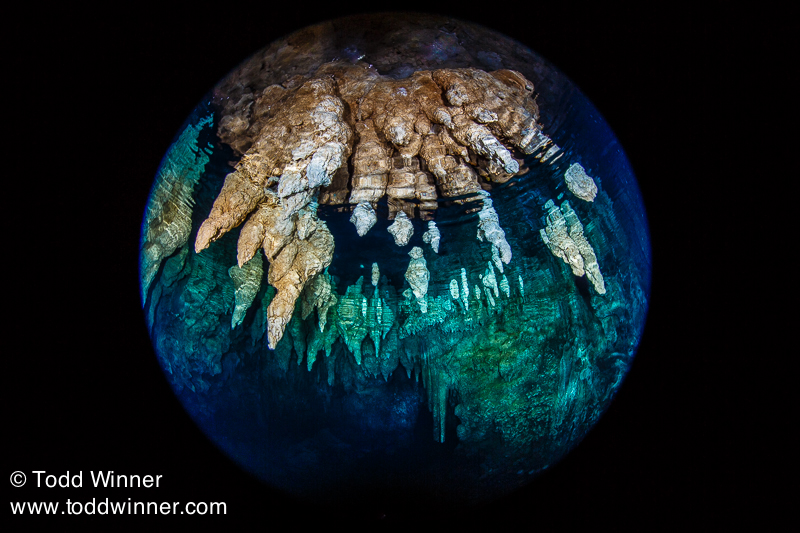 8mm Fisheye of Chandelier Cave. Palau[/caption]
[caption id="attachment_2552" align="alignright" width="250"]
8mm Fisheye of Chandelier Cave. Palau[/caption]
[caption id="attachment_2552" align="alignright" width="250"]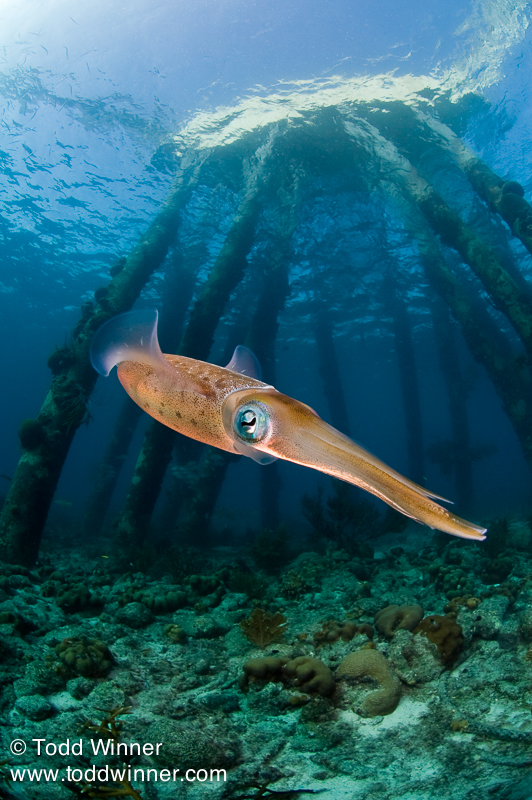 Caribbean Reef Squid, Sepioteuthis sepioidea, with salt pier in background, Bonaire, Netherlands Antilles, Caribbean Sea, Atlantic Ocean[/caption]
The Sigma 15mm f/2.8 is a popular choice for both Nikon and Canon full frame shooters.
It focuses close, has excellent image quality and is reasonably priced. The lens shade needs to be removed to use with some mini domes.
Nikon makes both the 16mm f/2.8 and 10.5mm f/2.8 fisheye lenses. Both are excellent quality but the 16mm does not focus close enough to use with a mini dome and the 10.5 is just not as versatile as the Tokina 10-17mm.
Other than those limitations, they work well underwater.
Caribbean Reef Squid, Sepioteuthis sepioidea, with salt pier in background, Bonaire, Netherlands Antilles, Caribbean Sea, Atlantic Ocean[/caption]
The Sigma 15mm f/2.8 is a popular choice for both Nikon and Canon full frame shooters.
It focuses close, has excellent image quality and is reasonably priced. The lens shade needs to be removed to use with some mini domes.
Nikon makes both the 16mm f/2.8 and 10.5mm f/2.8 fisheye lenses. Both are excellent quality but the 16mm does not focus close enough to use with a mini dome and the 10.5 is just not as versatile as the Tokina 10-17mm.
Other than those limitations, they work well underwater.
 A large crinoid (feather star) clings to a large sea fan along the steep wall of Table Coral City - Wakatobi.[/caption]
The main ingredient when it comes to shooting sharp, colorful images underwater is to reduce as much of the water between the camera and the subject. This means getting as close as possible, sometimes only inches, from your subject. Fisheye lenses for underwater allow us the opportunity to capture large animals and reef scenes without the need to recompose from further away.
We can also force perspective, making for some dramatic shots. Fisheye lenses focus extremely close, making them suitable for use with both mini domes, like the 4” Zen DP-100, and full size domes like the 8’” DP-200 and 9” DP-230. For more information about dome size, please see “The Right Dome - Size Matters”.
We also want to shoot as close as possible to capture colorful images. Water filters out color, starting with the red channel, so images shot at depth will have a blue color cast. To bring back the color in our photos we use underwater strobes, but to use them effectively we need to be within about five feet or less from our subjects. The following are a few of our favorite Digital SLR fisheye lenses for underwater photography.
[caption id="attachment_2554" align="alignleft" width="250"]
A large crinoid (feather star) clings to a large sea fan along the steep wall of Table Coral City - Wakatobi.[/caption]
The main ingredient when it comes to shooting sharp, colorful images underwater is to reduce as much of the water between the camera and the subject. This means getting as close as possible, sometimes only inches, from your subject. Fisheye lenses for underwater allow us the opportunity to capture large animals and reef scenes without the need to recompose from further away.
We can also force perspective, making for some dramatic shots. Fisheye lenses focus extremely close, making them suitable for use with both mini domes, like the 4” Zen DP-100, and full size domes like the 8’” DP-200 and 9” DP-230. For more information about dome size, please see “The Right Dome - Size Matters”.
We also want to shoot as close as possible to capture colorful images. Water filters out color, starting with the red channel, so images shot at depth will have a blue color cast. To bring back the color in our photos we use underwater strobes, but to use them effectively we need to be within about five feet or less from our subjects. The following are a few of our favorite Digital SLR fisheye lenses for underwater photography.
[caption id="attachment_2554" align="alignleft" width="250"] Split shot of giant kelp and a ship[/caption]
The Tokina 10-17mm f/3.5-4.5 is by far the most popular wide angle lens for crop sensor DSLRs. It is versatile with an equivalent range of about 15-26mm on a full frame sensor.
It’s available for both Canon and Nikon mounts and they do make the NH (no hood) versions without a built in lens shade for use with full frame bodies.
Just remember, that on a full frame body, you only have a usable zoom range of 15-17mm. Anything wider than 15mm and you will see rounded corners. It’s reasonably priced with excellent image quality.
The Canon 8-15mm f/4L is a dream come true for Canon underwater shooters. It can be used on both cropped and full frame cameras and has image quality equal or better than most fisheye primes. On a cropped sensor body like the EOS 7D, it is usable from 10-15mm.
Anything wider than 10mm will start to show rounded corners.
[caption id="attachment_2550" align="aligncenter" width="600"]
Split shot of giant kelp and a ship[/caption]
The Tokina 10-17mm f/3.5-4.5 is by far the most popular wide angle lens for crop sensor DSLRs. It is versatile with an equivalent range of about 15-26mm on a full frame sensor.
It’s available for both Canon and Nikon mounts and they do make the NH (no hood) versions without a built in lens shade for use with full frame bodies.
Just remember, that on a full frame body, you only have a usable zoom range of 15-17mm. Anything wider than 15mm and you will see rounded corners. It’s reasonably priced with excellent image quality.
The Canon 8-15mm f/4L is a dream come true for Canon underwater shooters. It can be used on both cropped and full frame cameras and has image quality equal or better than most fisheye primes. On a cropped sensor body like the EOS 7D, it is usable from 10-15mm.
Anything wider than 10mm will start to show rounded corners.
[caption id="attachment_2550" align="aligncenter" width="600"] Stingrays weren't the only attraction at Stingray City![/caption]
On a full frame body, like the EOS 5D Mark III, you either use it as a circular fisheye for underwater at the 8mm end or as a full frame fisheye racked out at 15mm. It also works well with the Kenko Teleplus PRO 300 DGX 1.4x teleconverter, making it a 11-21mm equivalent and giving you a usable zoom range of about 15-21mm.
[caption id="attachment_2553" align="aligncenter" width="600"]
Stingrays weren't the only attraction at Stingray City![/caption]
On a full frame body, like the EOS 5D Mark III, you either use it as a circular fisheye for underwater at the 8mm end or as a full frame fisheye racked out at 15mm. It also works well with the Kenko Teleplus PRO 300 DGX 1.4x teleconverter, making it a 11-21mm equivalent and giving you a usable zoom range of about 15-21mm.
[caption id="attachment_2553" align="aligncenter" width="600"] 8mm Fisheye of Chandelier Cave. Palau[/caption]
[caption id="attachment_2552" align="alignright" width="250"]
8mm Fisheye of Chandelier Cave. Palau[/caption]
[caption id="attachment_2552" align="alignright" width="250"] Caribbean Reef Squid, Sepioteuthis sepioidea, with salt pier in background, Bonaire, Netherlands Antilles, Caribbean Sea, Atlantic Ocean[/caption]
The Sigma 15mm f/2.8 is a popular choice for both Nikon and Canon full frame shooters.
It focuses close, has excellent image quality and is reasonably priced. The lens shade needs to be removed to use with some mini domes.
Nikon makes both the 16mm f/2.8 and 10.5mm f/2.8 fisheye lenses. Both are excellent quality but the 16mm does not focus close enough to use with a mini dome and the 10.5 is just not as versatile as the Tokina 10-17mm.
Other than those limitations, they work well underwater.
Caribbean Reef Squid, Sepioteuthis sepioidea, with salt pier in background, Bonaire, Netherlands Antilles, Caribbean Sea, Atlantic Ocean[/caption]
The Sigma 15mm f/2.8 is a popular choice for both Nikon and Canon full frame shooters.
It focuses close, has excellent image quality and is reasonably priced. The lens shade needs to be removed to use with some mini domes.
Nikon makes both the 16mm f/2.8 and 10.5mm f/2.8 fisheye lenses. Both are excellent quality but the 16mm does not focus close enough to use with a mini dome and the 10.5 is just not as versatile as the Tokina 10-17mm.
Other than those limitations, they work well underwater.





